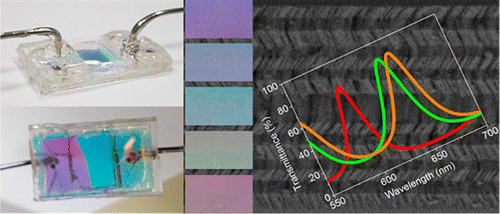M. Oliva-Ramirez , L. González-García , J. Parra-Barranco , F. Yubero , A. Barranco , A.R. González-Elipe
ACS Applied Materials and Interfaces, 5 (2013) 6743–6750
doi: 10.1021/am401685r

Porous Bragg microcavities formed by stacking a series of porous nanocolumnar layers with alternate low (SiO2) and high (TiO2) refractive index materials have been prepared by physical vapor deposition at glancing angles (GLAD). By strictly controlling the porosity and refractive index of the individual films, as well as the relative orientation of the nanocolumns from one layer to the next, very porous and nondispersive high optical quality microcavities have been manufactured. These photonic structures have been implemented into responsive devices to characterize liquids, mixtures of liquids, or solutions flowing through them. The large displacements observed in the optical spectral features (Bragg reflector gap and resonant peak) of the photonic structures have been quantitatively correlated by optical modeling with the refractive index of the circulating liquids. Experiments carried out with different glucose and NaCl solutions and mixtures of water plus glycerol illustrate the potentialities of these materials to serve as optofluidic devices to determine the concentration of solutions or the proportion of two phases in a liquid mixture.

